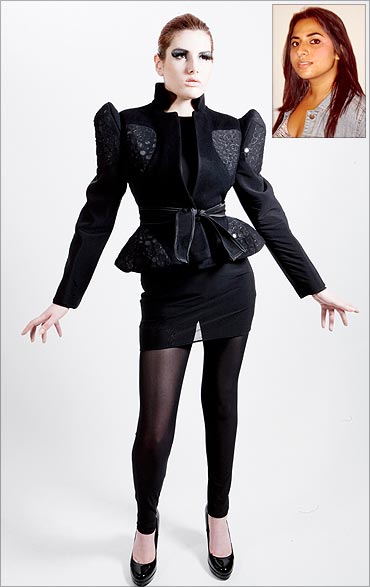
One of the newest kids on the block offers us her perspective on all things fashion.
She's young, she's talented and she's hoping to make a big splash in the Indian fashion industry.
Meet 25-year-old designer Jelin George -- fresh from the London College of Fashion, she tells us how she got selected to showcase at Lakme Fashion Week, why she's ambitious enough to launch her own label right away and shares tips with youngsters aspiring to a career in fashion. Presenting edited excerpts from an interview:
Tell us how you got into fashion.
I've always been interested in fashion, from school itself. I just applied to NIFT five years ago and I got in. Then I went on to obtain my BA degree in fashion technology from the London College of Fashion, which took three years. It's been really easy for me, you know, wherever I've applied I've always gotten through.
I completed the course in March, wrapped up with graduation and now I'm back and looking at starting my own label.
What was your parents' reaction to your professional choice? Were they supportive?
No, I wouldn't say they were supportive. They were a little apprehensive because there's a whole different side to the fashion industry and that's the first thing parents stop to think about. But I convinced them (laughs).
When you think fashion, you think glamour and coming from the kind of family that I do, it was a choice they were concerned about -- I have two younger sisters who have taken up medicine and architecture. But parents only want the best for their children and I managed to convince them and now they're happy with how things have shaped up for me so far.

Who would you say inspired you the most to get into fashion?
I think my mother, because I've seen her collection of saris growing up. She has every possible kind and you know, even though she doesn't wear them, it's just that she has them stocked in her cupboard. It's like, 'Okay, I own this sari!' And once in a while she'll remove them and spread them out -- it's just fascinating to see the colours and techniques used to create them. So it's always been there, that fascination for fashion and it came from looking at my mum's wardrobe.
You studied fashion at NIFT and then spent three years abroad getting a degree in design technology. What kind of a comparison can you draw between the two experiences?
I think first of all the most important thing is the way coaches talk to you. I think here in India, especially at NIFT, you are told to do certain things, whereas over there they give you a project and it's just your views. The teacher just guides you. So everyone's work has a different outcome. Over here, if you have to perform a particular task, everyone does the same thing -- maybe just the colours or the fabrics are different. So the take on studying is quite different in London.
How important would you say it is for aspiring designers to try for foreign credentials, over and above studying fashion in India?
I think it's good, it's better because you get international exposure. Rarely do you have students interning at fashion houses during the course in India. Over there, you spend a whole semester only in internship. You can even use your summer vacation to intern somewhere -- the designers abroad are always open to taking on interns.
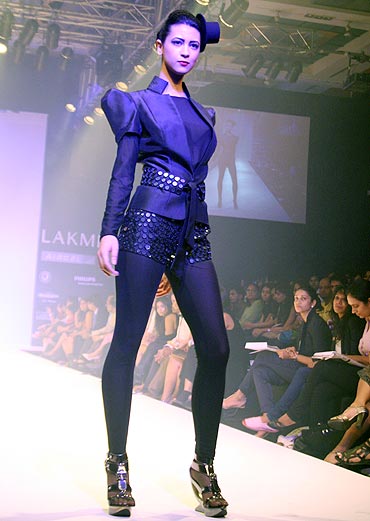
Who did you intern with while you studied in London?
She's an upcoming designer, Roksanda Ilincic. She's been part of London Fashion Week for the past three years. I interned with her for four to five months, as part of the course.
Most young designers start out working with established names in the business before moving to create their own brand. What made you decide to launch your own label right away?
I got through Lakme (Fashion Week), so I think it's the right thing to do. Depending upon the response, I'll decide whether to move base to Mumbai or to return to London. Ideally, I'd like to launch my label in India.
The time is ripe for me to start off, at least in terms of design. I'm not really strong on production, but that I can figure out eventually. As a designer, however, I'm quite confident of putting my talent out there.
How did Lakme Fashion Week happen? What are your expectations after showcasing there?
I just applied after graduation and I was selected. According to reports there were 172 applicants and six of us got through. In fact, two fellow GenNext designers are really good friends of mine and there's also another friend I studied in London with; she did the same course as me.
I was just hoping for a positive response from everyone, because it was my first showing ever and you get your first real reactions right there, from your first show. I'm also hoping to learn from it -- if there was anything lacking this time around, I'll have to try and do better at the next one.
I'm also hoping for international buyers to show interest, but they're not the only reason I did the show. I just want people to know that there is a new talent here, there is potential and I want to sell out all my garments.
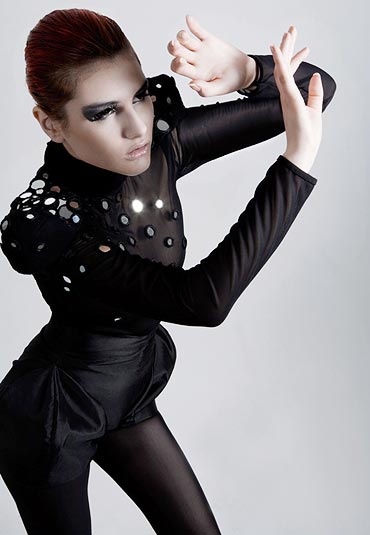
Tell us a little bit about your LFW collection.
It's called 'I desire too much' and it's very '80s inspired, from style icons like Grace Jones, with big shoulders, strong lines, strong silhouettes. But what I always try to do is incorporate embroidery techniques from India and contemporise things -- not in a very traditional way, though.
Where do you draw inspiration from for your work?
I think it's everything around me. I may just walk down the street and see someone or something. Like yesterday for example, I was going somewhere by auto(rickshaw) and I saw this wall, which was drawn over and painted with colours and it had a sort of shine to it that got my thought process started. Can I use this deep colour? Can I use that kind of technique? So anything you see it just hits you, you realise that yeah, maybe I can use this for my next collection, or for maybe a small line.
In the Indian fashion industry, which designer is your favourite?
I think my all-time favourite is Manish Arora. His work is very international and that's what I like. I'm not too much into Bollywood and very Indian styles.
So does that cross ethnicwear off your list?
I am open to designing ethnicwear, but I would like to give it a very different take. I would not go with the usual flow, I'd add a little open element to it that's not usually found in the market.
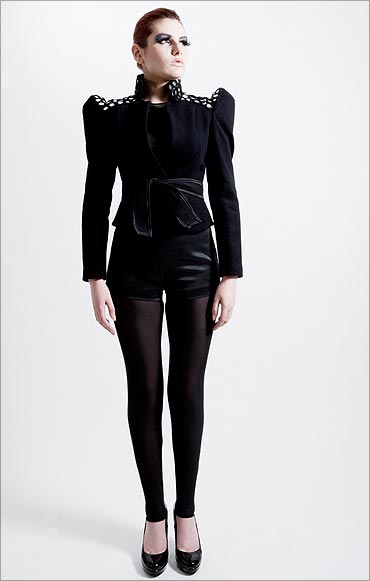
Which Western designer do you admire the most?
I like Alexander McQueen because he worked very cleverly with prints, made statements with them and even with his cuts and silhouettes. And everything goes along with everything else -- it's not like his prints are beautiful and the cuts are beautiful but that they don't go together.
What if you had to pick between the two -- Arora and McQueen?
They're both in different leagues because of the techniques they use. I think I'd just pick up the best from each and learn from that.
Do you think Indian designers are at par with the global fashion industry or do you think they still have a long way to go?
I think there's still a long way to go. The thing with Indian designers is that their focus is mainly on Indian wear -- they don't have many Western silhouettes or styles in their collections. I think they should use their Indian embroidery and techniques, which are so famous across the world on Western silhouettes, because ultimately if you want to tap that market you can't be designing ghagara cholis -- people won't buy that abroad.
Which Indian male and female celebrity would you like to see wearing your designs?
I'm not so much into menswear so I can't really say for a male celeb, but from among the Bollywood women I would like to design for Sushmita Sen; I think she can carry off a majority of styles with grace.
And among international celebrities?
It would have to be Angelina Jolie, because she's got a kind of an edge to her whole look and that's what I try to strive for with my designs.

Which celebrity according to you is a fashion icon?
Let's say Lady Gaga, because she comes out with very bizarre outfits! (laughs)
And here in India?
I think Sonam Kapoor is quite well-dressed nowadays from the new batch of actresses.
Can you give us the breakdown on 'high' vs 'low' fashion? What distinguishes one from the other?
I think it's just small elements that make the difference -- the finishing, all the details, the fabrics that you use
You will find in high fashion that the finishing has to be impeccable, the detailing cannot be what you'd find anywhere else and the fabric has to be of great quality. You always add that extra element to make it 'high' fashion.
What do you think of the price tags that accompany such high-end luxury items? Designer handbags, jackets and plenty of other products cost in the region of Rs 1,50,000 and over as a matter of course.
I think that sometimes they can be a little overpriced; it's not like anything goes in the name of fashion. But some of these items are worth the price, because there's a lot of effort and a lot of thought that goes into the product. And it's not just out there for everyone to buy, these pieces are like classics, timeless -- if you pick them up, you can use them anytime. You can even hand them over to your kids, you know, pass them down from generation to generation.
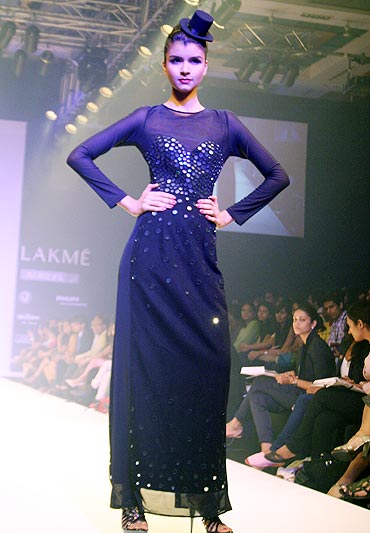
You've just made you entrance into the Indian fashion industry -- what would be your advice to youngsters who want to pursue the same career? What do you have to say to someone who is just starting out from the same point you were at five years ago?
I'd like to tell them that it's not just about the dresses you're designing; it's about the person you're designing for. You don't want someone to be lost in the whole styling process or the garment that you're creating. There's this really nice quote by Coco Chanel: "Look for the woman in the dress. If there is no woman, there is no dress." And that's something that I really follow, because if the style is not working for a person, don't go with it. Go for something that will bring out their personality.
Next, keep your eyes and ears open. Look around you, you'll find inspiration everywhere you go, you don't have to surf online for it!
Also, experiment -- don't just sit and say okay, this is not going to work, so let's not do it. Experimenting will help you find your own style of designing.
And finally, believe in yourself. That is what will get you through everything.
One last question: Would you say the fashion capital of India is Mumbai or Delhi?
I would say Mumbai, because I've never experienced the Delhi fashion scene.